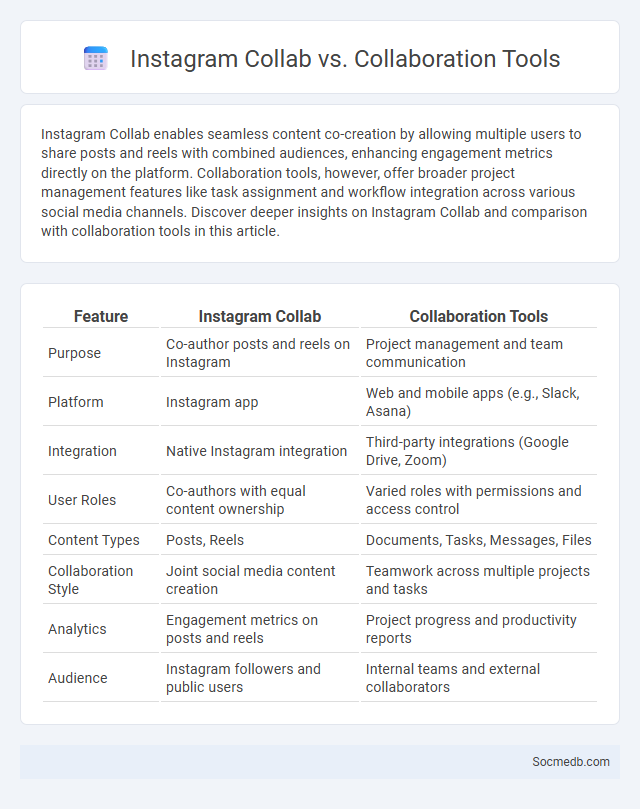
Photo illustration: Instagram Collab vs Collaboration Tools
Instagram Collab enables seamless content co-creation by allowing multiple users to share posts and reels with combined audiences, enhancing engagement metrics directly on the platform. Collaboration tools, however, offer broader project management features like task assignment and workflow integration across various social media channels. Discover deeper insights on Instagram Collab and comparison with collaboration tools in this article.
Table of Comparison
| Feature | Instagram Collab | Collaboration Tools |
|---|---|---|
| Purpose | Co-author posts and reels on Instagram | Project management and team communication |
| Platform | Instagram app | Web and mobile apps (e.g., Slack, Asana) |
| Integration | Native Instagram integration | Third-party integrations (Google Drive, Zoom) |
| User Roles | Co-authors with equal content ownership | Varied roles with permissions and access control |
| Content Types | Posts, Reels | Documents, Tasks, Messages, Files |
| Collaboration Style | Joint social media content creation | Teamwork across multiple projects and tasks |
| Analytics | Engagement metrics on posts and reels | Project progress and productivity reports |
| Audience | Instagram followers and public users | Internal teams and external collaborators |
Understanding Instagram Collab: What It Is
Instagram Collab is a feature that allows two users to co-author posts or Reels, sharing content with both audiences simultaneously. This collaborative tool increases reach and engagement by displaying the post on both profiles and appearing in followers' feeds of both collaborators. Brands and influencers leverage Instagram Collab to enhance visibility, drive cross-promotion, and build authentic partnerships.
Overview of Popular Collaboration Tools
Slack, Microsoft Teams, and Trello dominate the social media landscape as powerful collaboration tools enhancing team productivity. Slack offers real-time messaging and integrations with over 2,000 apps, fostering seamless communication. Microsoft Teams provides video conferencing, file sharing, and integration with Office 365, while Trello utilizes boards, lists, and cards to manage projects visually and efficiently.
Defining Collaboration in the Digital Age
Collaboration in the digital age revolves around leveraging social media platforms to connect, communicate, and coordinate efforts across diverse teams and communities worldwide. Your ability to share ideas, co-create content, and solve problems in real time transforms traditional workflows into dynamic, interactive experiences. These digital tools enable seamless integration of global perspectives, enhancing innovation and productivity through collective intelligence.
Key Features of Instagram Collab
Instagram Collab allows you to co-author posts or Reels, enabling shared visibility and engagement metrics between collaborators. Key features include mutual content ownership, synchronized likes and comments, and enhanced audience reach by combining follower bases. This tool optimizes content collaboration, increasing your social media presence through seamless partnership integration.
Advantages of Traditional Collaboration Tools
Traditional collaboration tools enhance communication by providing structured platforms such as email and document sharing, which ensure clear and organized information exchange. These tools offer reliability and security that modern social media platforms may lack, safeguarding sensitive data and maintaining workflow integrity. Your team benefits from consistent, focused collaboration environments that reduce distractions common in social media channels.
Comparing Instagram Collab to Collaboration Tools
Instagram Collab streamlines content co-creation by enabling joint posts and shared audiences directly within the app, optimizing brand visibility and influencer partnerships. Collaboration tools like Slack or Trello focus on project management and team communication, providing structured workflows and task tracking rather than content publishing. Brands seeking audience engagement benefit more from Instagram Collab, while internal team efficiency is better served by dedicated collaboration platforms.
Use Cases: When to Choose Instagram Collab
Instagram Collab is ideal for boosting engagement through joint content creation, making it perfect for brand partnerships, influencer campaigns, and collaborative product launches. You can leverage this feature to share followers, increase reach, and enhance credibility by showcasing authentic teamwork. When your goal is to amplify visibility with minimal effort, Instagram Collab offers a strategic advantage in social media marketing.
Use Cases: When to Use Collaboration Tools
Collaboration tools are essential for managing social media campaigns that require coordinated efforts across multiple team members, enabling seamless content creation, scheduling, and performance tracking. You can use these tools to streamline communication, assign tasks, and maintain consistency in brand messaging across platforms. Effective use of collaboration tools enhances productivity and ensures timely responses to audience engagement, crucial for social media success.
Instagram Collab vs Full-Scale Team Collaboration
Instagram Collab enables creators to co-author posts and reels, boosting audience reach by merging follower bases and improving engagement rates through shared content visibility. Full-scale team collaboration involves comprehensive project management tools, cross-platform integration, and the coordination of various roles to streamline content creation, strategy, and analytics reporting. Leveraging Instagram Collab is ideal for influencer partnerships, while full-scale team collaboration suits brand campaigns requiring multifaceted input and detailed workflow management.
Choosing the Right Collaboration Approach for Your Needs
Selecting the right collaboration approach for your social media strategy ensures maximum engagement and efficiency. Whether you prefer influencer partnerships, brand collaborations, or user-generated content campaigns, tailoring your approach to match your audience's preferences and platform strengths is crucial. Your ability to align collaboration methods with business goals drives meaningful interactions and measurable growth.
 socmedb.com
socmedb.com